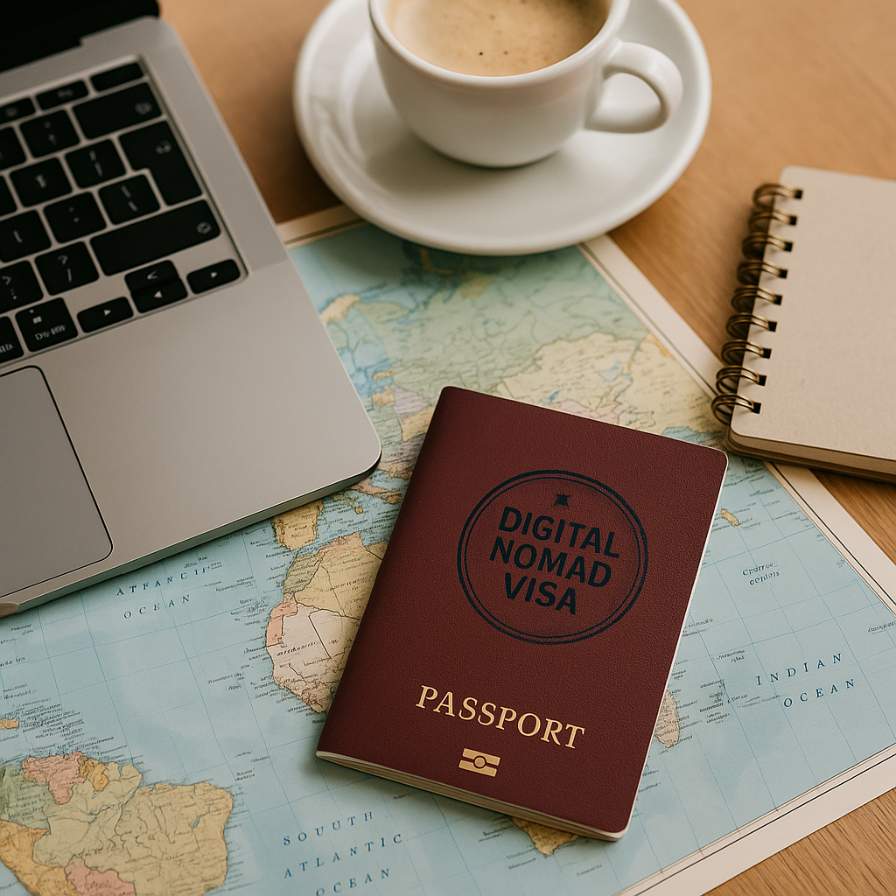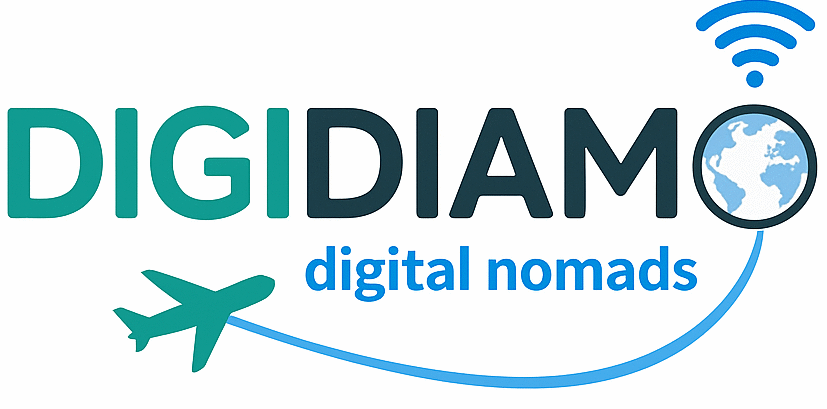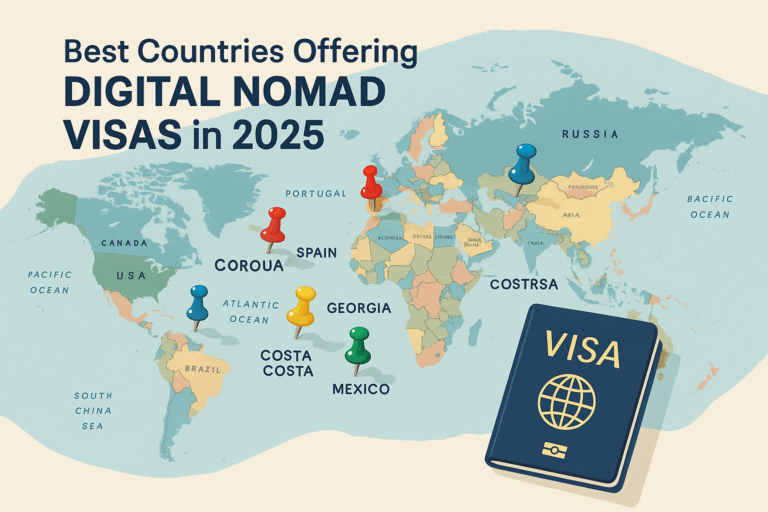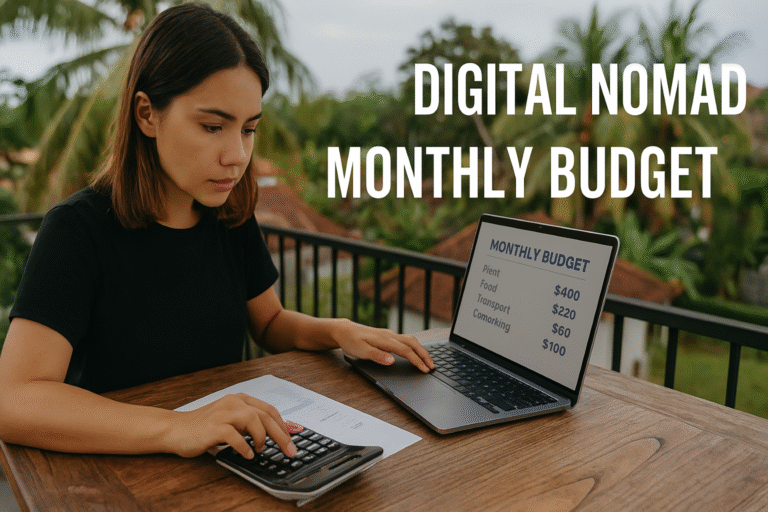Digital nomad visas 2025: The ultimate guide to working legally around the world
Introduction
Working remotely has opened doors that didn’t exist a decade ago. Now, you can build a career without being tied to one location, wake up in one country and take client calls from another. But with this freedom comes a challenge: how do you stay legal while living abroad?
Tourist visas were never meant for remote work. They’re short, restrictive, and often unclear when it comes to earning income. That’s why digital nomad visas have become a valuable alternative. More and more countries now offer these long-stay options designed specifically for remote professionals.
Whether you’re freelancing, running your own online business, or working remotely for a company, a digital nomad visa gives you time, space, and legal clarity. This guide walks you through the most important aspects where to go, how to apply, and how these visas compare to other options.

Best countries offering digital nomad visas in 2025
Not every country is ready to host digital nomads. But in 2025, a growing list is rolling out visas that make long-term remote work easier, safer, and more structured. The best ones combine fair requirements with a good quality of life, strong internet, and a welcoming community.
Portugal remains one of the top destinations. The income requirement is around €3,040/month, and you’ll need to show proof of remote work. Cities like Lisbon and Porto are well known, but places like Madeira and the Algarve offer a quieter lifestyle with lower rent.
Spain introduced its digital nomad visa recently, asking for roughly €2,500/month in income. Barcelona and Valencia are popular, but more affordable cities like Malaga are gaining traction among remote workers looking for better value.
If you’re after stability and modern infrastructure, Estonia has a straightforward application process. With an income threshold of €3,500/month, it’s not the cheapest, but it offers strong digital systems and a safe environment. Tallinn is small but efficient, and the country’s natural beauty is a bonus.
For something more relaxed, Croatia offers a visa with a lower income requirement about €2,300/month. The coastline, islands, and affordable living make it especially appealing to freelancers who don’t need a big city.
Latin America also steps in with solid options. Mexico doesn’t offer a formal digital nomad visa, but its temporary resident visa works similarly and lasts up to four years. The income requirement is around $2,600/month, and cities like Oaxaca and Playa del Carmen have strong nomad communities.
Costa Rica has a dedicated digital nomad visa launched in 2022. It requires $3,000/month in income and comes with tax benefits on foreign earnings. Beach towns like Santa Teresa offer a balanced lifestyle for those who mix work with outdoor living.
If budget is a concern, Georgia allows many nationalities to stay up to one year without a visa, and its official remote work program requires only $2,000/month. The cost of living is low, and Tbilisi is a rising hub for remote workers in search of somewhere different.
On the higher end, Dubai (UAE) offers a visa for $5,000/month earners. While expensive, it gives access to a global city with top-notch services and a strong business network. It’s ideal for those who work with international clients and need reliable infrastructure.
Each destination has its trade-offs, so your choice depends on budget, lifestyle, and professional needs. For more details, you can explore a full breakdown of the best countries currently offering digital nomad visas.
How to apply for a digital nomad visa
Once you’ve chosen your destination, the next step is figuring out how to apply. The process isn’t complicated, but it does require preparation. Most countries want to be sure you can support yourself, that you work remotely, and that you won’t use local resources like jobs or healthcare without contributing.
The first thing to check is the income requirement. This varies from country to country. Some accept around $2,000 per month, while others ask for more than $4,000. Make sure your financial documents bank statements, invoices, or salary slips clearly show stable income.
You’ll also need to prove your remote work status. If you’re employed, a letter from your company confirming your position and remote arrangement is usually enough. Freelancers might need to show multiple client contracts or consistent payment history.
Next, gather your supporting documents. These often include:
- Passport valid for at least six months
- Proof of income or savings
- Remote work proof (employment or freelance contracts)
- Health insurance covering your stay
- Accommodation booking or lease
- Background check (sometimes)
Some countries also ask for passport photos, translated documents, or notarized forms. Organize everything in a shared folder it’ll make uploading or printing much easier later.
Once your documents are ready, complete the application. Some governments allow online submissions, while others require a visit to an embassy or consulate. Be sure to double-check file size limits and accepted formats if you’re applying online.
Fees are usually paid at submission and range from $100 to $400. Processing times can vary widely from 2 weeks to 2 months so apply early, especially if you’re planning around a lease or flight.
After approval, you’ll receive a visa sticker, a digital permit, or a notice to finalize your application in person. Some countries will require local registration once you arrive, especially in Europe. This might involve visiting a town hall, immigration office, or police station to confirm your address and receive an ID card.
To stay ahead of delays or mistakes, it helps to know what to expect in each step. If you want a full step-by-step with tips on documents, timing, and common issues, check out the detailed guide to applying for a digital nomad visa.
Digital nomad visa vs tourist visa vs work visa
When deciding how to live and work abroad, the type of visa you choose matters more than you might think. Each one comes with its own rules, limits, and risks. Understanding the differences helps you avoid problems down the road whether it’s getting kicked out early, paying unexpected taxes, or struggling to rent a place legally.
Tourist visas are the most common starting point. They’re easy to get, usually require little paperwork, and allow short stays typically 30 to 90 days. But they’re not meant for working, even if your job is remote. Some people manage just fine using tourist visas, but the risk is real. In some countries, immigration officers might ask questions about your income or job. If they think you’re working while visiting, they can refuse entry.
A digital nomad visa, by contrast, is designed for people like us remote workers who want to stay longer and avoid legal grey areas. These visas usually last from 6 months to a year and make it clear you’re allowed to work online, as long as your income comes from outside the country. That means fewer headaches, no visa runs, and more stability.
You’ll also have access to basic services. With a digital nomad visa, you can often sign leases more easily, open a local bank account, and sometimes register for healthcare. It creates a clearer relationship between you and the country you’re living in.
Work visas are something else entirely. They require a job offer from a local employer and are usually much harder to get. In most cases, they involve sponsorship, tax registration, and often language or residency requirements. These are best suited for people relocating permanently or joining a local company not for independent freelancers or remote employees.
Another key point is tax residency. Tourist visas usually don’t trigger taxes, since you’re not staying long enough. But with a digital nomad visa, if you spend more than 183 days in a country, you could become a tax resident. That’s not always a bad thing some countries offer favorable tax regimes but it’s something to consider.
In short:
- Tourist visa: quick, short, unofficial for work
- Digital nomad visa: legal for remote work, medium to long term
- Work visa: tied to a local employer, more complex
If you’re still not sure which fits your situation best, this comparison of visa types for remote work lays out the pros and cons clearly.
Conclusion
The rise of digital nomad visas has changed the way remote professionals approach life abroad. Instead of hopping from country to country on short-term tourist visas, you now have the option to stay longer, settle in, and live without constantly checking your calendar for expiration dates.
Whether you’re looking for sunshine and low living costs or stability and access to services, there’s probably a visa that fits your lifestyle. The key is choosing a destination that aligns with your income level, personal needs, and work habits. And once you’ve picked your spot, the application process is manageable with a bit of preparation.
If you’re ready to take the next step, start by exploring which countries offer the best digital nomad visas it’s the simplest way to narrow your options and make an informed decision.






